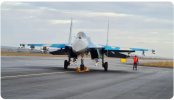Lockheed sees opportunity to build battlefield networks for foreign air forces
By Garrett Reim
15 February 2022
Lockheed Martin believes foreign militaries will follow the US Air Force’s (USAF’s) example and fund development of battlefield networks of their own.
The company is involved in development of the USAF’s Advanced Battle Management System (ABMS), a network that is supposed to allow aircraft to quickly pass around information about the battlefield, enabling US pilots to get a jump on the enemy. Lockheed is also competing in a similar Australian Defence Force programme called Project AIR6500.
At the core of the USAF’s ABMS vision is the Lockheed F-35 stealth fighter, which the Department of Defense has described as a “quarterback” that will gather information about the battlefield and then call plays. Lockheed bills the F-35 as the “most advanced node” in the service’s network.
Yet, battlefield networks of the future will connect many different pieces of equipment, including ground vehicles and ships, as well as various aircraft. That means each network is likely to be custom built, says Tim Cahill, Lockheed Martin senior vice-president for global business development and strategy.
A desire to be interoperable with US forces will likely drive some commonality and standards across militaries, especially those that are allies or partners of Washington. However, the requirement to network legacy aircraft and other equipment will mean customisation will be inevitable.
“Once you build out some of these pieces, I think you’ve got the opportunity perhaps to take them to other countries and drop them in whole,” says Cahill. “But, my guess is there’s going to be some significant adaptation.”
While all-encompassing battlefield networks are cutting-edge currently, Lockheed envisions the systems will eventually become must-have technology.
“It’s going to be necessary to win the fight,” says Cahill. “It’s going to become an enabler… and so, it’s by definition going to be a relatively large segment of the market at some point in the future.”




